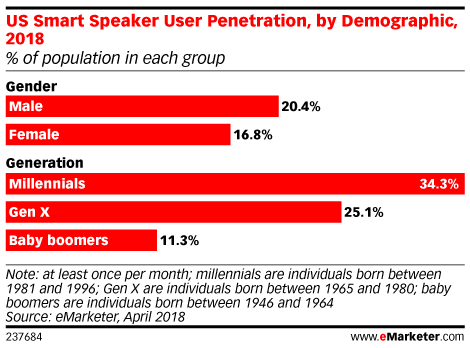There’s no doubt that smart speaker usage has grown in popularity over the last year. With their simple design and low-cost affordability, it’s really no surprise that smart speakers like the Amazon Echo and Google Home have become mainstays in the homes of many. The momentum that voice-activated devices have behind them is only going to snowball as we move into 2019 and beyond.
There’s plenty of evidence to support this notion. According to eMarketer, roughly 74.2 million people will use smart speakers. And by the conclusion of 2019, roughly 27 percent of all American adults will use such devices at least once a month.
What are some other statements being made about smart speakers and their widespread adoption? Thanks to eMarketer, which recently detailed a series on the usage of these devices by generation, we can point out a few big ones. Here are five.
Millennials, specifically older ones, are the core users of smart-speaker technology.
Roughly 34.3 percent of all voice-enabled devices are millennials. The older millennials, according to eMarketer forecasting analyst, Jaimie Chung, lead the way largely due to possession of their own households as well as the wealth to own such devices. As a generation known for early adoption, Millennials are also seemingly more patient with smart speakers, arguably still in the beginning phases of their development.

Younger baby boomers are using smart speakers much more than teenagers.
Year over year, adoption of voice-enabled devices by boomers has grown a little more than 25 percent. The reason for their popularity among this cohort is in a smart speaker’s simplicity. Unlike smartphones and tablet devices, talking to an Amazon Echo or Google Home is much easier than typing. Also as boomers age, voice-enabled speakers allows them continued access to information while their physical skills, such as mobility, go into decline.
Gen X’ers prefer to keep their voice-activated usage private.
Chung notes that Millennials are much more willing to utilize artificial intelligence technology through voice in public more so than their older counterparts. Gen X’ers, like older millennials, are more likely to be homeowners which also makes their preferred private use of voice-activated speakers understandable. Also worth noting? Most Gen X users of smart speakers happen to be younger Gen X women, who utilize these devices to “help them complete their daily tasks, much as a true personal assistant would.”
Kids are more avid users of smart speaker devices than teenagers.
Defined as children ages 11 and under by eMarketer, kids are found to embrace smart speakers much more than teens. Close to 99 percent of voice assistant users are defined as kids compared to just 50 percent of teenagers ages 12 to 17. The reason? Teens just have a different access point to voice assistants than kids. Chung notes that compared to kids, teenagers are utilizing voice technology on smartphones, which they often now receive as a rite of passage at their age. Chung also notes the following difference between kids and teens:
“Higher smartphone ownership and more independence are the obvious causes of this trend, but another factor at play is that teens are digital natives who have adapted to the screen interface while kids are growing up alongside voice technology and don’t view voice as new or strange. Smart speakers are increasingly becoming another member of the household for kids.”
Amazon’s share of the smart speaker market is declining.
They have first-mover advantage, but Amazon has seen their competition make major strides in the smart-speaker market. eMarketer forecasted that Echo’s adoption among US smart-speaker users will drop below two-thirds for the very first time. Google Home is expected to account for 31 percent of voice-activated users while smaller players such as the Apple HomePod will account for 12 percent.

